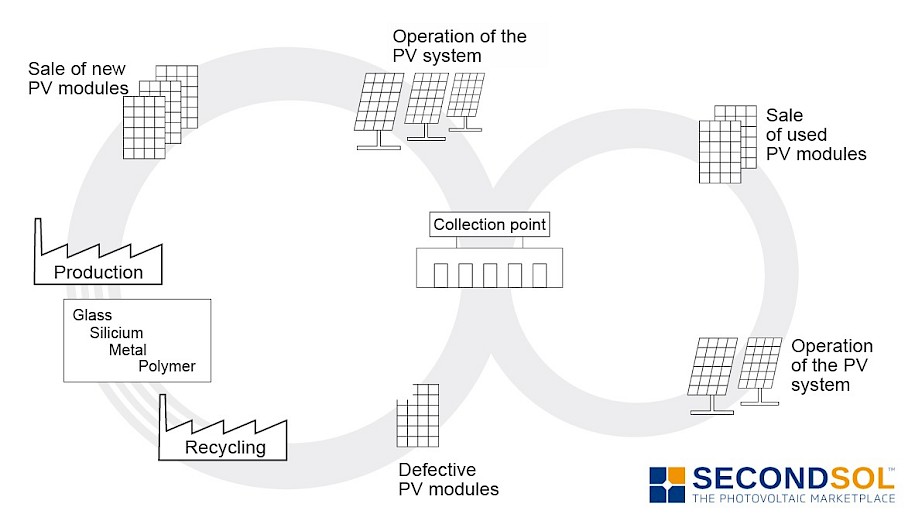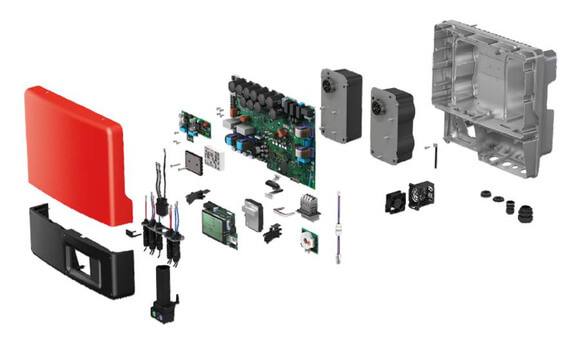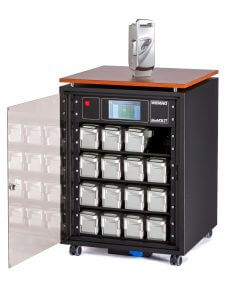
Recycling and disposal of photovoltaic modules
Taking back and recycling old photovoltaic modules, inverters and all other components after damage, the end of a photovoltaic system's service life or its repowering is a major issue.
Here you can find out whether a photovoltaic system can be completely returned to the recycling cycle and how the individual products behave.
The recycling of a photovoltaic system is a great advantage for the economy and the environment, because after all, around 95% of the materials used can be used to build new solar systems.
Recycling of photovoltaic modules
In order to create a uniform solution for the return of photovoltaic modules in Europe, the EU Commission has drawn up a corresponding directive for the disposal of electrical and electronic equipment. First of all, the PV industry should be given the opportunity to set up its own EU-wide, comprehensive take-back system for old modules via the PV Cycle® take-back program. However, this did not work.
The WEEE2 for solar modules
The classification of PV modules under the European WEEE Directive was decided by the EU Parliament and Council as part of WEEE2 in 2012. Manufacturers and other first distributors (importers) must register their PV modules according to the specifications of the respective countries before they can be placed on the market or offered and sold in Europe.
Since the WEEE directive is implemented nationally by the respective countries, each EU member state has its own legal regulation governing the sale and return of PV modules. For this reason, there is currently no single, EU-wide take-back system that organizes and handles take-back and disposal across Europe. Instead, WEEE compliance must be set up in the countries either via the importing customer or individually.
Incidentally, in addition to the manufacturers of photovoltaic modules, large retailers and Internet shops are also affected by the obligation to take back old PV modules.
Recycling or secondary market?
The recycling of old solar modules that come from repairs, dismantling or repowering is continuously being perfected. The costs for the recycling and disposal of modules amount to approx. 80.00 euros per ton for crystalline solar modules and to approx. 120.00 euros per ton for thin-film modules. There is no doubt that costs will continue to fall in the coming years.
However, solar modules that have reached their commercial age do not always have to be disposed of immediately. If the modules are visually still completely intact and have an age-appropriate performance, they can be used as replacement modules for existing systems or for use in new photovoltaic systems. This has the advantage that you get money for your used modules and also provides an additional benefit for the environment.

Disposal of Inverters
In terms of waste law, inverters for photovoltaic systems fall under the "non-hazardous" waste code number AVV 16 02 14. This applies to all inverters that do not contain capacitors containing polychlorinated biphenyls (PCBs). However, if capacitors containing PCBs are installed in the inverters, these must be registered and disposed of under the "dangerous" waste code number AVV 16 02 10.
However, used inverters are usually free of PCBs and can be dismantled into their various assemblies by the recycling companies. The components after dismantling are iron, plastics, transformer scrap and circuit boards.
According to information from the manufacturer SMA, two different strategies can be followed when recycling:
- material recycling (recovery of raw materials)
- product recycling (reuse of assemblies)
However, inverters from repowering and refitting are not always defective. Inverters that are still functional can be used as spare parts for existing photovoltaic systems or for use in new photovoltaic systems.


Recycling of electricity storage
The power storage devices used in photovoltaics fall under the category of industrial batteries. In Europe there are functioning collection systems for batteries and modern processes that make it possible to recycle all types of used batteries. Depending on the type of battery, recycling rates are currently over 80 percent.
Li-ion batteries and rechargeable batteries as a valuable source of raw materials
Old power storage devices, e.g. Li-ion batteries and accumulators, can be converted into valuable raw materials by recyclers in the processing plants. The recyclers manage to convert more than 50 percent of the battery components into raw materials that can be used further.
Disposal of cables, plugs, substructure and Co.
The remaining components such as cables, plugs, substructure and system monitoring can also be recycled or reused. If it has to be disposed of, you already get money for cables, plugs and substructure. The level of remuneration is always based on the current "scrap" prices for copper, aluminum and steel. Traders for scrap metal often pick up old cables & co. directly on site. Small devices such as monitoring systems, display boards etc. can also be disposed of easily and often free of charge at collection points for old electrical equipment.
In order to protect the environment, however, all components of a photovoltaic system that are still functional should be recycled. These can be given a second life quickly and easily via the SecondSol online marketplace.




